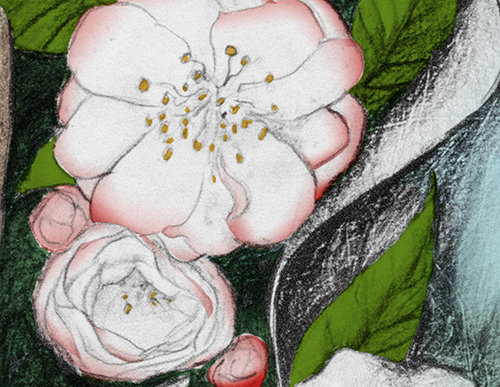As Designers & Forests begins each project, we define a conceptual framework to study the region in which we are working. With Hidden Frontiers, the history of Central and Western New York is our inspiration. This is an area that has been called the American frontier, the Steel Belt, the Rust Belt, and the Burned Over District.
The Burned Over District is a term used by historians, sociologists, and sundry others, to describe the area of Central and Western New York scorched with the fire of social reform and millennial fear from the late 18th to the mid 19th centuries. It was the birthplace of an unusually high number of secular and religious utopian movements—movements that sought to redefine the ways humans interact with each other and with their environments. Of course, such interactions are also the focus of Designers & Forests.
We spend months researching in preparation for our workshops. During this process, we were captivated by a 1876 Currier and Ives print, Friendship Love and Truth, found in the United States Library of Congress. This print inspired the Hidden Frontiers call for entries poster. Certainly, the inspiration is formal, but it also influenced the use of symbolism hidden in the illustration. The final piece is a mix of stories, experiences, history, and ecology. It is a statement of our inspiration and beliefs.
The Hand and Compass.
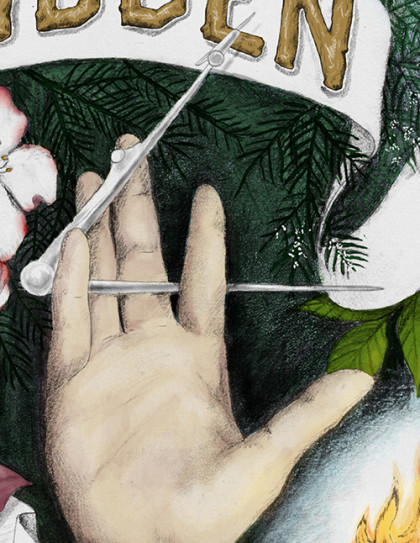 While the compass is commonly associated with the Masonic Order, the position of this hand and compass is a direct reference to the 1924 photomontage The Constuctor by El Lissitzky. He was one of the leading members of the Russian avant-garde movement, Constructivism, and his work influenced designers and artists throughout Europe. His graphic design had such a great impact that it laid the foundation for a substantial portion of the Modernist design movement and it is not hyperbole to call Lissitzky one of the most important figures in the history of the discipline.
While the compass is commonly associated with the Masonic Order, the position of this hand and compass is a direct reference to the 1924 photomontage The Constuctor by El Lissitzky. He was one of the leading members of the Russian avant-garde movement, Constructivism, and his work influenced designers and artists throughout Europe. His graphic design had such a great impact that it laid the foundation for a substantial portion of the Modernist design movement and it is not hyperbole to call Lissitzky one of the most important figures in the history of the discipline.
The Hand and Heart
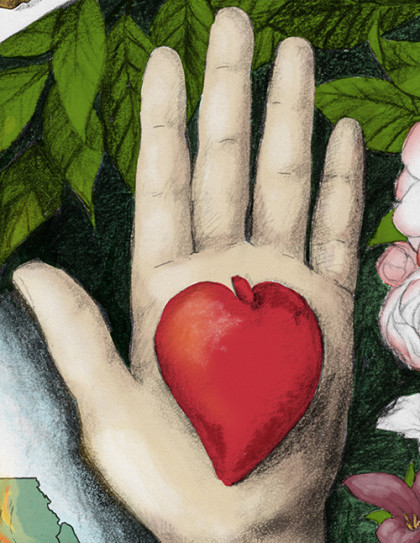 The hand and heart is a symbol associated with the United Society of Believers in Christ’s Second Appearing, commonly known as The Shakers. It is the embodiment of a key teaching of the faith’s founder, Mother Ann Lee—“hands to work, hearts to God” —the creation of goods to the best of the makers ability, without waste and without flourish. Shakers even viewed particularly inspired works or buildings as “gifts” from god. While such an idea is not unfamiliar, the Shakers saw divine inspiration in a barn that allowed for efficient feeding and housing of cattle, rather than in a cathedral or a sculpture. Designers & Forests also finds inspiration in the axiom in that it represents acting to create change rather than merely discussing what is wrong in the world.
The hand and heart is a symbol associated with the United Society of Believers in Christ’s Second Appearing, commonly known as The Shakers. It is the embodiment of a key teaching of the faith’s founder, Mother Ann Lee—“hands to work, hearts to God” —the creation of goods to the best of the makers ability, without waste and without flourish. Shakers even viewed particularly inspired works or buildings as “gifts” from god. While such an idea is not unfamiliar, the Shakers saw divine inspiration in a barn that allowed for efficient feeding and housing of cattle, rather than in a cathedral or a sculpture. Designers & Forests also finds inspiration in the axiom in that it represents acting to create change rather than merely discussing what is wrong in the world.
Sugar Maple Leaves and Hemlock Branches with Woolly Adelgid
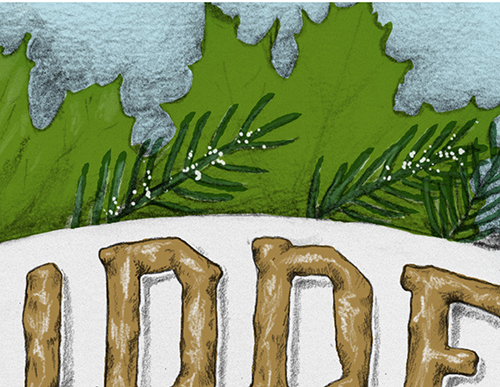 New York State produced 17% of the United States’ maple syrup with a value of $21,676,00 in 2014 according to the US Department of Agriculture. Yet this number represents only 5% of the state’s sugar maple (Acer saccharum) trees tapped. Maple trees are found throughout the Eastern Deciduous Forests and sugaring is a tradition dating to the First Peoples.
New York State produced 17% of the United States’ maple syrup with a value of $21,676,00 in 2014 according to the US Department of Agriculture. Yet this number represents only 5% of the state’s sugar maple (Acer saccharum) trees tapped. Maple trees are found throughout the Eastern Deciduous Forests and sugaring is a tradition dating to the First Peoples.
The eastern hemlock (Tsuga canadensis) is a key species for the health of eastern decidous forests, providing habitat for many animals. It is a late succession species that takes 250 to 300 years to mature. With such slow growth and a history of heavy foresting, there are few mature trees left in the United States. Now, the hemlock is being devastated by the woolly adelgid (Adelges tsugae). This insect appears as small cotton-like balls nestled between the tree’s needles where it feeds on food storage cells killing the hemlock in as little as four years and wiping out stands throughout the Eastern United States.
Dutchmen’s Britches, White Ash Leaves, and the Emerald Ash Borer
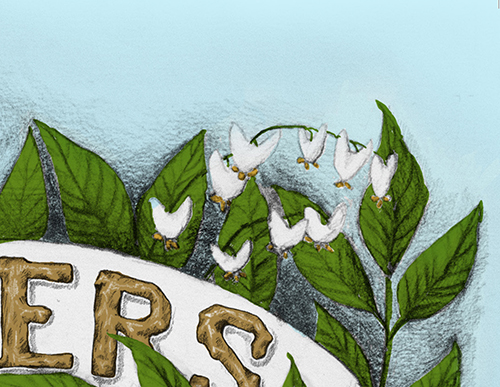 Dutchman’s britches are native spring ephemerals that have adapted to live on the forest floor and sprout, flower, pollinate, and seed in the short period after the winter snows melt and before the trees’ spring foliage develops. Having evolved to rely on the bumblebee for pollination, these plants could be adversely effected if their populations are not stabilized.
Dutchman’s britches are native spring ephemerals that have adapted to live on the forest floor and sprout, flower, pollinate, and seed in the short period after the winter snows melt and before the trees’ spring foliage develops. Having evolved to rely on the bumblebee for pollination, these plants could be adversely effected if their populations are not stabilized.
The white ash (Fraxinus americana), green ash (Fraxinus pennsylvanica), and black ash (Fraxinus nigra), are all commonly found in the eastern deciduous forests. They are important to forest ecosystems, providing shelter and food for many native animals, and have long been used for their wood. The white ash is traditionally prized for furniture and tool making, in building, and to make baseball bats. The green ash is used for similar purposes, although it is not as desired. The black ash is usually found in swamps and, although its wood is not as resilient as the other members of the genus, it is prized for traditional basketmaking.
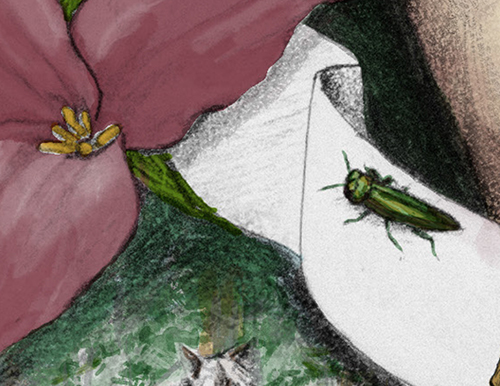 Appearing in the United States in 2002, the emerald ash borer (Agrilus planipennis) is an invasive species that attacks ash trees. With no natural defense, it is predicted as many as 99% of all ash trees in the country will be killed, with green and blue ash the most heavily affected. The potential impact is so great that foresters often speak of these trees in the past tense, canopy holes in the making. While the future of the eastern deciduous forest is uncertain, between the emerald ash borer and the woolly adelgid, there will be a massive change in the ecosystem.
Appearing in the United States in 2002, the emerald ash borer (Agrilus planipennis) is an invasive species that attacks ash trees. With no natural defense, it is predicted as many as 99% of all ash trees in the country will be killed, with green and blue ash the most heavily affected. The potential impact is so great that foresters often speak of these trees in the past tense, canopy holes in the making. While the future of the eastern deciduous forest is uncertain, between the emerald ash borer and the woolly adelgid, there will be a massive change in the ecosystem.
Red and White Trillium
The red trillium, or Stinking Benjamin (Trillium erectum), 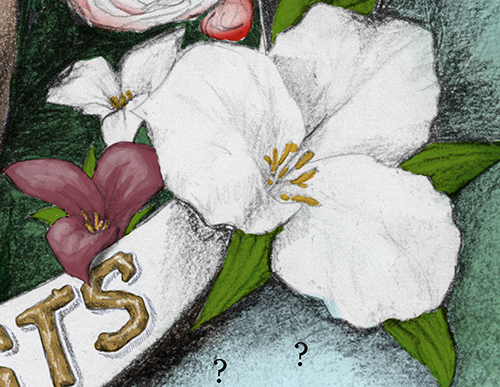 and white, or giant, trillium (trillium grandiflorum), are found in the rich soil of the deciduous forest of New York State and Pennsylvania. They create dense patches in the early spring forests as spring ephemerals. To those who grew up in rural New York, these blooming of the trillium is the sign that spring has arrived. However, as they are slow to mature and the whole plant is killed if their leaves are removed they are also listed as endangered, or exploitedly vulnerable, in several states.
and white, or giant, trillium (trillium grandiflorum), are found in the rich soil of the deciduous forest of New York State and Pennsylvania. They create dense patches in the early spring forests as spring ephemerals. To those who grew up in rural New York, these blooming of the trillium is the sign that spring has arrived. However, as they are slow to mature and the whole plant is killed if their leaves are removed they are also listed as endangered, or exploitedly vulnerable, in several states.
Apple Blossoms, Empire Apples, Concord Grapes and Chanterelle Mushrooms.
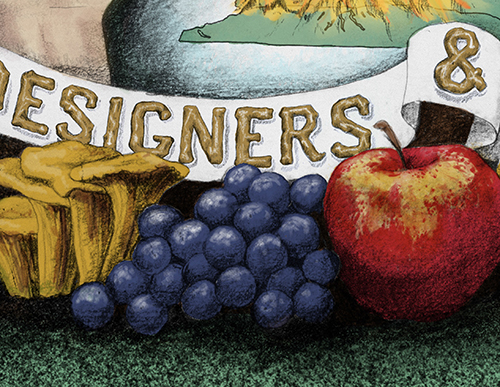 Apples are a pillar of New York State agriculture. The state ranks second in the United States for production with 29,500,000 bushels of the fruit grown. In the spring, the white and pink blossoms are everywhere and in the fall the fruit are ubiquitous. The Empire variety was developed in 1945 at the New York Agricultural Research Station in Geneva, New York as a cross between a Macintosh and a Delicious. As part of Cornell University, this institution is responsible for documenting and preserving some 6,883 distinct varieties as part of the National Apple Collection. This staggering number is in stark contrast to estimates of the RAFT (Renewing America’s Food Traditions) Alliance “that 86 percent of the thousands of different apples that existed before 1900 have been lost, only 11 varieties account for 90 percent of the apples sold in supermarkets, and 41 percent of those are Red Delicious”.
Apples are a pillar of New York State agriculture. The state ranks second in the United States for production with 29,500,000 bushels of the fruit grown. In the spring, the white and pink blossoms are everywhere and in the fall the fruit are ubiquitous. The Empire variety was developed in 1945 at the New York Agricultural Research Station in Geneva, New York as a cross between a Macintosh and a Delicious. As part of Cornell University, this institution is responsible for documenting and preserving some 6,883 distinct varieties as part of the National Apple Collection. This staggering number is in stark contrast to estimates of the RAFT (Renewing America’s Food Traditions) Alliance “that 86 percent of the thousands of different apples that existed before 1900 have been lost, only 11 varieties account for 90 percent of the apples sold in supermarkets, and 41 percent of those are Red Delicious”.
The fall nights in Chautauqua County are full of the scent of ripe concord grapes, and a large portion of the region’s economy is based on this crop—It is the largest producer of grapes in the state and ranks 13th in the country. In fact, the National Grape Cooperative Association, Inc., which owns Welches, was started here in Brocton, NY 1945, and Welches itself was located in nearby Westfield, N.Y. beginning in 1893. Welches was a pillar of the local economy until it moved its offices out of the area in 2002, although there are still a number of processing plants in the region.
Chanterelle mushrooms can be found in forests throughout Europe and the United States. When Designers & Forests was in Utah during Beetle Kill and Aspen Die-Off, our Swedish collaborators fixed a memorable meal from pounds of these foraged mushrooms. Although Chanterelle are not particularly common in Western New York, an increasing number of farmers are experimenting with cultivating mushrooms on forested sections of their land.
Missing Honey Bees
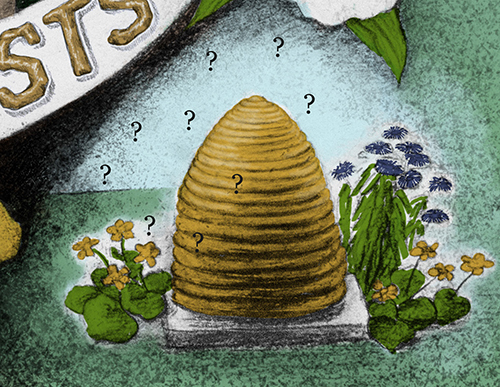 Honey bees around the world are disappearing. Colony Collapse Disorder has left one-third of the beehives in the United States empty and many plants and farmers without their main source of pollination. Without these pollinators, many of the foods we eat, and trees we rely on, simply cannot grow. What is causing honey bees to disappear? Recently several studies have shown conclusively that neonicotinoid insecticides, which are widely used, contribute significantly to Colony Collapse Disorder. However, it is a mystery that is only now starting to be unravelled
Honey bees around the world are disappearing. Colony Collapse Disorder has left one-third of the beehives in the United States empty and many plants and farmers without their main source of pollination. Without these pollinators, many of the foods we eat, and trees we rely on, simply cannot grow. What is causing honey bees to disappear? Recently several studies have shown conclusively that neonicotinoid insecticides, which are widely used, contribute significantly to Colony Collapse Disorder. However, it is a mystery that is only now starting to be unravelled
Draft Horse Logging
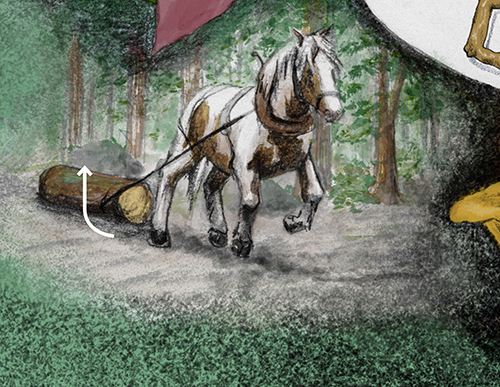 Before the gigantic machines of modern mechanized logging, timber was cut by axe and saw, moved by draft animals, and floated down rivers to mills. While hand saws and river transport are no longer used, smaller animal-towed skids are making a comeback in American silviculture. When properly rigged, draft animals have a much lower impact on the forest ecosystem, and allow for “worst first” selective logging.
Before the gigantic machines of modern mechanized logging, timber was cut by axe and saw, moved by draft animals, and floated down rivers to mills. While hand saws and river transport are no longer used, smaller animal-towed skids are making a comeback in American silviculture. When properly rigged, draft animals have a much lower impact on the forest ecosystem, and allow for “worst first” selective logging.
Groups like the Healing Harvest Forest Foundation and the Foundation for Sustainable Forests are working to shift the practice of forestry from clear-cut industrial logging to an approach that addresses the whole health of a stand with individual trees. Forests are logged to improve conditions for a more robust, diverse ecosystem and a long term revenue stream rather than one large cut every few decades that results in both diminishing returns for the land owner and diminishing health of the ecosystem.


